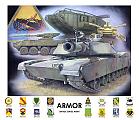I’m relatively new to SWJ and was asked by Granite State in the “Tell Us About You2” thread to discuss FCS and small wars. As an add on, there is some good FCS discussion in the “Army Future: Invade Azerbaijan” thread. So, I’m providing some insights into the FCS brigade combat team (FBCT) capabilities and how this modernization program is leveraging and infusing technology to the current force.
Today and tomorrow's operating environment (OE) require currently undefined levels of security for not only successful military operations, but also for partner nations to thrive in other areas relative to security and national power. That said, the adversary will seek to deter US involvement, isolate the US from local support or allies, and block the entrance to the country in which they are operating or lure us into “their zone.” Adding complexity to the OE are adversaries who have “gone to school” on US operations including protracted, simultaneous, full spectrum operations in difficult and diverse terrain (urban). Fueling the fire even more is that the adversary in some cases has niche capabilities better than ours, is a master of IO, and abides by no rules. This was borne out by the recent Herzbollah/IDF war in which the fight was on complex terrain in “their zone”; relying on low visibility and prepared defenses; and, with secured LOCs enabling Hezbollah to mass rockets, ATGMs, RPGs, and mortars.
Enter the FBCT, which is designed for complex urban environments. Compared to the HBCT it has 10X more unmanned assets, 6X more sensors (which are all networked), 2X more infantry soldiers (boots on the ground), and is 3X more reliable and maintainable. The eight variants of the MGV have increased lethality and survivability, are chemical and bio hardened, have a 360 degree hemispheric active protection system, are the primary node for sharing information, and carry most of the FBCT’s sensors. Insights from the OMNI FUSION 2007 COIN experiment documented that tactical FBCT formations are more survivable and lethal than current tactical units in the COIN urban environment (can provide more insight if needed).
At the tactical level of operations the FBCT has:
- Self-contained units with reliable equipment and greater situational awareness, do not need operational pauses, thus keeping continuous pressure on adversaries
- Multi-layered, unmanned ground and air systems dramatically increasing situational awareness and reach, and increased force protection by doing more of the dangerous and dirty jobs.
- Battle command on the move; more robust staffs dealing with the full range of military operations.
- High situational awareness available at the lowest levels empowering all leaders.
- Smaller footprint due to greater reach-back and more reliable equipment.
- Combat units are fully networked; interdependent land forces leveraging all Joint capabilities.
- Mitigating our increased difficulty in concealing our intentions (surprise).
Testimony from recently deployed Soldiers who participated in FCS Experiment 1.1 held at Ft. Bliss/WSMR indicated that the equipment used during the experiment could be used in theater now including the Small Unmanned Ground Vehicle (SUGV), Class I UAV, and tactical and urban unattended ground sensors (T-UGS/U-UGS). On 22 July 2004, Army officials announced plans to accelerate the delivery of selected FBCT capabilities to the Current Force. The Army will accelerate fielding of select FBCT capabilities (called Spin Outs) to reduce operational risk to the Current Force. Spin Out 1 (SO 1) will initiate testing in FY08 and consist of prototypes issued to the Army Evaluation Task Force (AETF) for their use and evaluation. Following successful evaluation, production and fielding of SO 1 will commence to Current Force units. SO 1 will include T-UGS/U-UGS, NLOS-LS, JTRS, and Integrated Computer “B-Kit” for Abrams, Bradley, and HMMWV. This process allows FCS capabilities being put in soldier’s hands sooner than the core program current schedule. SO 2 will initiate its testing in FY 2010 and will consist of the integration of the program’s Active Protection Systems (APS), the Manned Ground Vehicle Mast Mounted Sensor to Stryker, the SUGV, and the Class I UAV. SO 3 will initiate testing in FY 2012. This SO will leverage heavily on core program events. SO 3 will include these FCS systems: Armed Robotic Vehicle –Assault- Light, Class IV UAV, and FCS Battle Command Network that will replace current ABCS in current force operation centers. The FCS network will benefit not just the Army, but the entire joint force, which will also be network-enabled.
The Army’s FCS approach is the most effective way to leverage current resources in order to modernize the force and to maintain readiness while investing in programs that extend U.S. military advantages into the future. As CSA GEN Casey has observed, the cost of modernizing is measured in dollars; the failure to modernize too often is measured in lives. Without FCS modernization, the Army will get new equipment, but no new capabilities. Our Soldiers absolutely require new capabilities to prevail against a learning and adaptive enemy who is not standing still.
Thanks for the opportunity to contribute.









 .
.

 - although I'm still a few years shy
- although I'm still a few years shy

Bookmarks